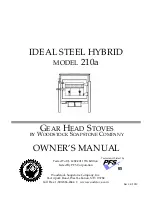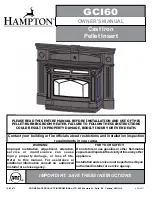
should be at least 2 inches of clearance between the chimney and floor joists or other com-
bustible materials. Poor flashing between the chimney and the roofline can cause leaks and
deterioration of chimney mortar.
You should make preliminary checks, but if you have any doubts, or are unfamiliar with
chimney construction, cleaning, or maintenance, have a local fire official or certified chimney
professional inspect your chimney. If repairs are required, be sure to use someone who is
knowledgeable in chimney work and familiar with local code requirements.
In addition: All brick or cinder block chimneys should have clean out access with a tightly fit-
ting door. Masonry chimneys should have a wash at the top. All chimneys should have a cap to
keep out rain and snow and to minimize downdrafts caused by wind.
Passing Through A Combustible Wall:
With an exterior chimney, in most cases the chimney connector (or stove pipe) will need to pass through a combustible
wall. The following are acceptable methods:
A.
Use a section of Solid Insulated Prefabricated Metal Chimney to connect to the chimney - Use a section of insulated
prefabricated 2100° Class A chimney pipe listed to UL 103 HT (at least 1” of insulation or greater) the same inside diameter
as the stove pipe and maintain a 9” air space between the wall of the prefabricated chimney and the combustible wall. This
section of chimney pipe can be supported by a sheet metal plate securely fastened to the combustible wall, with a hole cut in
the middle of it. This will close the gap around the chimney pipe and the framed opening. (See Diagram A Below)
B.
Build a solid brick surround around a tile liner - Frame a 3.5” thick brick surround into the combustible wall you need to
pass through. Maintain a minimum 12” brick separation from the clay liner to combustibles. The minimum 5/8” thick clay
liner should be cemented in place and run from the outer surface of the brick to the inner surface of the chimney. (See
Diagram B Below)
C.
There are also UL Listed kits available that are specifically designed for passing through a combustible wall. For more
information on these kits, please contact Woodstock Soapstone Company. Please note: there are several UL listed wall pass
through kits available, always follow the specific manufacturers installation instructions. (See Diagram C Below)
For other methods, please refer to NFPA 211.
REMEMBER, UNPROTECTED SINGLE OR DOUBLE WALL STOVE PIPE SHOULD NOT PASS THROUGH A
COMBUSTIBLE WALL OR CEILING TO CONNECT TO THE CHIMNEY. YOU MUST USE AN APPROVED METHOD
WHICH PROVIDES GREATER PROTECTION THAN SINGLE OR DOUBLE WALL PIPE.
Prefabricated Metal Chimneys:
For high efficiency, freestanding woodstoves, like your Woodstock Soapstone stove, a Prefabricated
Metal Chimney must be listed as Class A and carry a UL Listing of 103 HT (high temperature). The “UL
103 Type HT Class A” prefabricated chimney will have a temperature rating of 2,100° F.
There are prefabricated chimney systems that are approved only to 1,700° F and are suitable only for
fireplace inserts or factory built fireplaces.
DO NOT
use these with your Woodstock Soapstone stove.
At the point of the first penetration of a combustible surface (i.e., wall or ceiling) all subsequent
venting components need to be prefabricated “UL Type HT Class A”. If your prefabricated chimney
Connecting your stove to a
masonry thimble.
The minimum clearance for a single wall
metal stovepipe and terra cotta thimble at the
chimney connection is 12”
A.
Using a Prefabricated Metal Chimney section
to connect to an existing masonry chimney
located behind a combustible wall
Use a UL listed and approved wall pass thru kit.
B.
Refractory
Cement
Insulated
section of
factory built
chimney
Sheet
Steel
Supports
9”
9”
9”
9
Refractory
Cement
Fireclay Thimble
12”
12”
12”
12
Stainless Steel
Connector
C.
UL listed
insulated
thimble
Minimum required
air space
Listed wall
protector &
cover shield
UL 103 HT Stainless
Chimney Connection
3








































